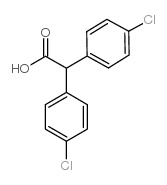4,4'-DDA

4,4'-DDA structure
|
Common Name | 4,4'-DDA | ||
|---|---|---|---|---|
| CAS Number | 83-05-6 | Molecular Weight | 281.13400 | |
| Density | 1.373g/cm3 | Boiling Point | 411.4ºC at 760 mmHg | |
| Molecular Formula | C14H10Cl2O2 | Melting Point | 167-169ºC(lit.) | |
| MSDS | Chinese USA | Flash Point | 202.6ºC | |
| Symbol |


GHS07, GHS08 |
Signal Word | Warning | |
|
Mitotane (1-(o-chlorophenyl)-1-(p-chlorophenyl)-2,2-dichloroethane) metabolism in perfusion studies with dog adrenal glands.
Drug Metab. Dispos. 15(2) , 267-9, (1987)
|
|
|
Oxidation at C-1 controls the cytotoxicity of 1,1-dichloro-2,2- bis(p-chlorophenyl)ethane by rabbit and human lung cells.
Drug Metab. Dispos. 23(5) , 595-9, (1995) Isolated rabbit Clara cells and a transformed human bronchial epithelial cell line, BEAS-2B, were used to investigate the mechanism of cytotoxicity of 1,1-dichloro-2,2-bis(p-chlorophenyl)ethane (DDD), a persistent insecticide and stable metabolite of 1,1,1-tr... |
|
|
Development of an enzyme-linked immunosorbent assay for the quantification of DDA (2,2-bis(p-chlorophenyl) acetic acid) in urine.
Bull. Environ. Contam. Toxicol. 38(5) , 798-804, (1987)
|
|
|
[The enzymatic degradation of DDT. 6. The fate of the DDT metabolites dichlorodiphenyldichloroethylene and dichlorodiphenylmonochloroethylene in the rat].
Nahrung 31(3) , 253-7, (1987) DDE is hydrogenated in the rat organism. The distribution of the compound is described. DDMU is degradated to DBP as well as transformed to DDA and DDOH. Excretion and distribution are studied. |
|
|
Interaction of structurally similar pesticides with organic anion transport by primary cultures of winter flounder renal proximal tubule.
J. Pharmacol. Exp. Ther. 266(2) , 673-7, (1993) We assessed the interaction of several pesticides with renal organic anion transport based on inhibition of the active transepithelial transport of p-aminohippuric acid ([3H]PAH) by primary cultures of winter flounder proximal tubules. Four structurally simil... |
|
|
Occurrence of DDA in DDT-contaminated sediments of the Southern California Bight
Mar. Pollut. Bull. 64(7) , 1300-8, (2012) Highlights ► DDA, a water-soluble DDT metabolite, occurs in DDT-contaminated sediments. ► DDA levels occurred only at wastewater outfalls where DDT levels were present. ► DDA is missed by usual environmental monitoring procedures for DDT contamination. ► DDA ... |
|
|
Induction of tolerance in macrophages by cholera toxin B chain.
Pathobiology 67(5-6) , 314-7, (1999) Model systems of human type 1 diabetes have revealed an important role of cellular immune reactions involving macrophages and T cells in the destruction of autologous insulin-producing pancreatic beta cells. Recently, the cholera toxin B chain (CTB) was found... |
|
|
Effects of L-arginine on the afferent resting activity in the cephalopod statocyst.
Brain Res. 845(1) , 35-49, (1999) The effects of bath application of the nitric oxide (NO) precursor L-arginine (L-ARG) on the resting activity (RA) of afferent crista fibers were studied in isolated statocysts of the cuttlefish Sepia officinalis under various experimental conditions. L-ARG (... |
|
|
2,2-bis(4-Chlorophenyl)acetic acid (DDA), a water-soluble urine biomarker of DDT metabolism in humans.
Int. J. Toxicol. 28(6) , 528-33, (2009) DDT metabolism in humans yields DDA as the principal urinary metabolite and potential exposure biomarker. A method for DDA analysis in human urine was developed using pentafluorobenzyl bromide and diisopropylethyl amine. Dried hexane extracts were reacted for... |
|
|
The effect of lead on insecticide metabolism.
Drug Chem. Toxicol. 9(3-4) , 239-52, (1986) The possibility that lead could affect the metabolism of the insecticide 1,1-dichloro-2, 2-bis(p-chlorophenyl)ethane, DDD, was examined by studies of the effects of chronic oral Pb treatment on DDD conversion to 2,2-bis(p-chlorophenyl)acetic acid, DDA. Rats w... |